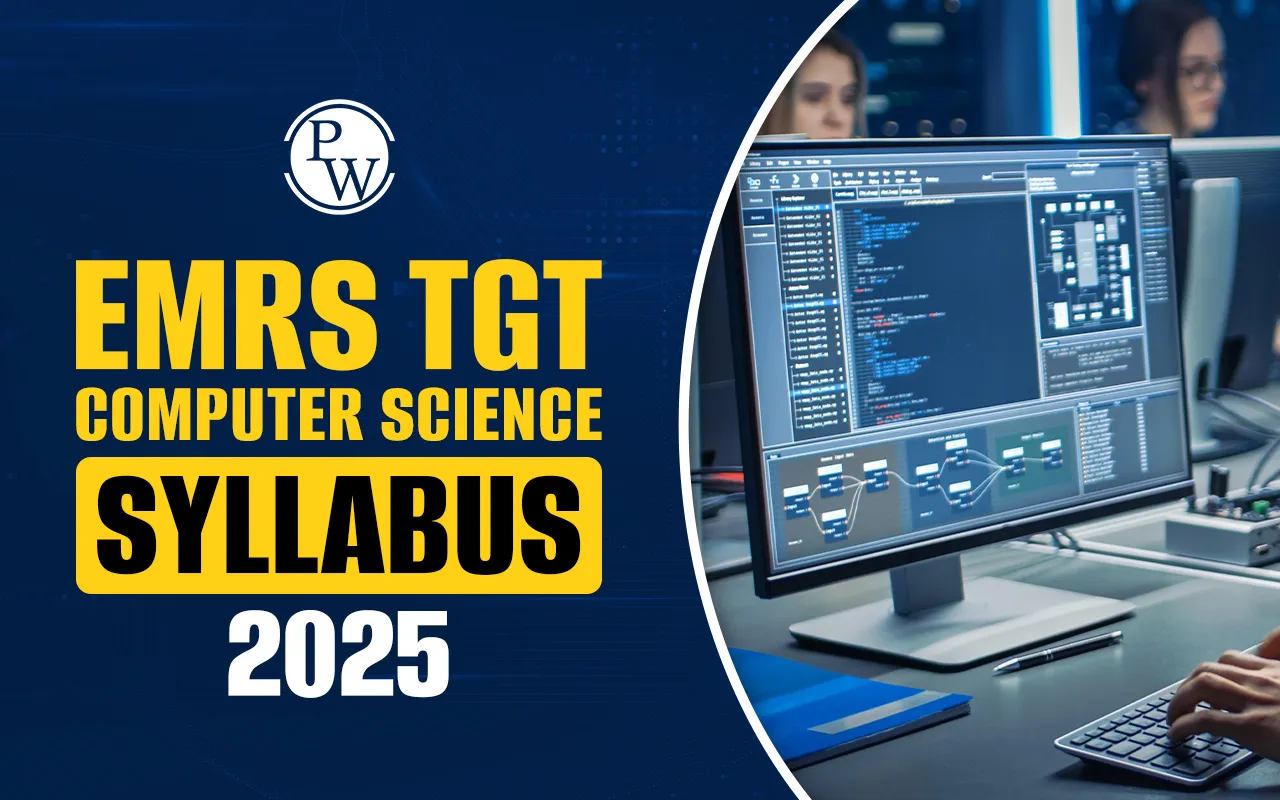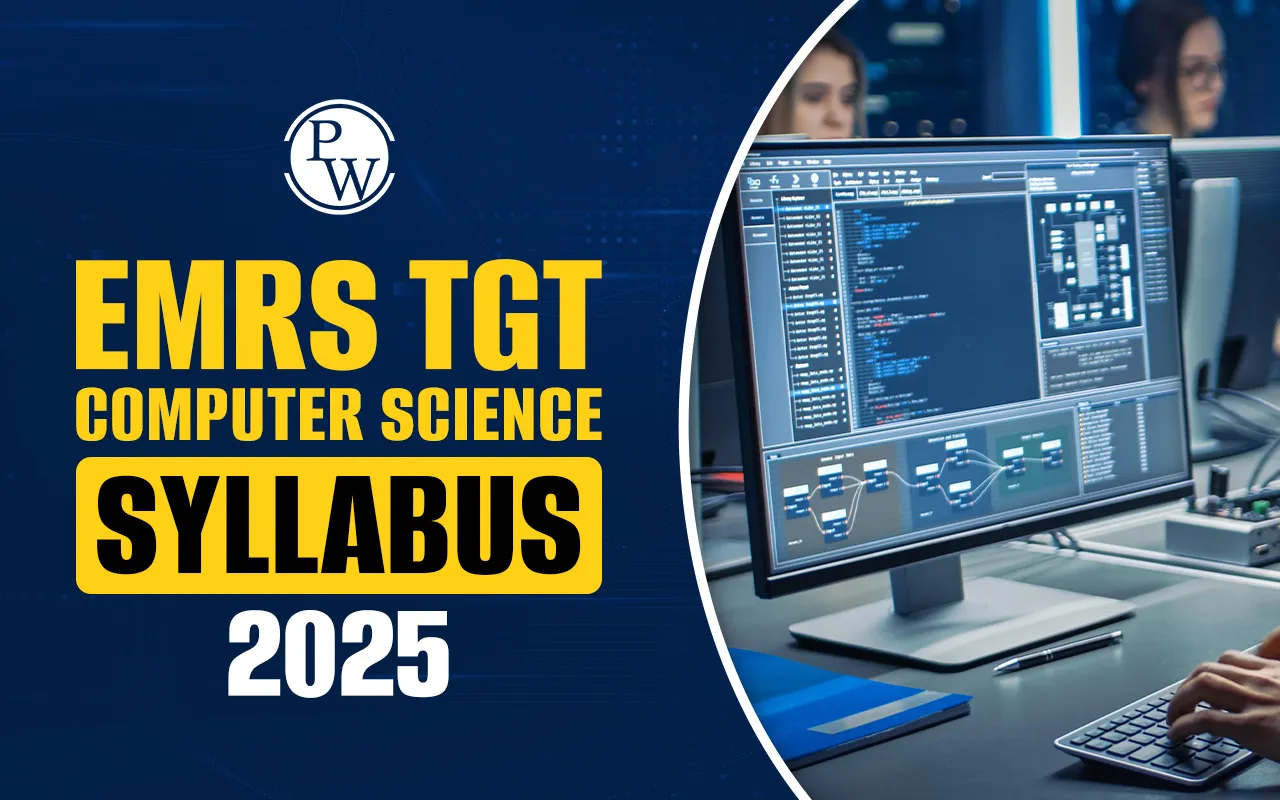

EMRS TGT Computer Science Syllabus 2025 covers all the important aspects that candidates need to cover for their preparation for the National Education Society for Tribal Students (NESTS). EMRS TGT Computer Science Syllabus highlights key areas of computer systems, programming, and more.
Therefore, understanding the EMRS TGT Computer Science Syllabus PDF and Exam Pattern helps aspirants prepare systematically for the EMRS TGT Recruitment 2025. Thereby, ensuring clarity on subject coverage and question distribution for effective exam readiness.
EMRS TGT Recruitment 2025
EMRS TGT Recruitment 2025 aims to fill various teaching and non-teaching posts across India. The selection process includes a written examination followed by document verification. Candidates are advised to go through the detailed syllabus and exam pattern before starting their preparation.
| EMRS PGT Syllabus 2025 Overview | |
| Particulars | Details |
| Conducting Body | National Education Society for Tribal Students (NESTS) |
| Posts | Teaching and Non-Teaching posts (PGTs, TGTs, Principal, Hostel Warden, Female Staff Nurse, Accountant, JSA, Lab Attendant) |
| EMRS Vacancy 2025 | 7267 |
| Mode of Application | Online |
| Mode of Exam | OMR Based (Pen-Paper) |
| Duration of Exam | 3 hours |
| Level of Exam | National Level |
| Job Location | Across India |
| Official Website | https://nests.tribal.gov.in |
EMRS TGT Computer Science Syllabus PDF
EMRS TGT Computer Science Syllabus PDF can be downloaded from the official NESTS website or through the recruitment section of the EMRS portal. Infact, candidates can also download from the below direct link provided. It contains a detailed description of topics from each section that are essential for exam preparation. The syllabus is divided into seven major sections, as outlined below.
Detailed EMRS TGT Computer Science Syllabus 2025
Mentioned here is the detailed EMRS TGT Computer Science Syllabus 2025. Check the table below for complete information:
| Detailed EMRS TGT Computer Science Syllabus 2025 | ||
| Unit / Section | Key Topics | Detailed Syllabus Coverage |
| 1. Computer Systems and Organisation | Basic Computer Organisation | Computer system overview; hardware & software; input/output devices; CPU; memory types – primary, cache, secondary; units of memory (Bit, Byte, KB, MB, GB, TB, PB); memory hierarchy; semiconductor memory; DRAM organization. |
| Types of Software | System software (OS, utilities, drivers); programming tools (assembler, compiler, interpreter); application software. | |
| Operating System | Functions of OS; user interface concepts. | |
| Boolean Logic | Logic gates (AND, OR, NOT, NAND, NOR, XOR); truth tables; De Morgan’s laws; logic circuits. | |
| Number System | Binary, Octal, Decimal, Hexadecimal systems; conversions between number systems. | |
| Encoding Schemes | ASCII, ISCII, Unicode (UTF-8, UTF-32). | |
| System Buses | Components and interconnection of the computer system; bus architecture (address, data, control buses); PCI bus concept. | |
| CPU Structure | Register and stack organization; instruction formats; addressing modes; RISC vs CISC architectures. | |
| Application Software | Word Processor, Spreadsheet, Presentation Tools. | |
| 2. Computational Thinking and Programming | Problem Solving | Steps: analyzing problem, algorithm, coding, testing, debugging; flowcharts and pseudocode; decomposition. |
| Python Basics | Introduction, features, “Hello World”, execution modes (interactive/script); character set; tokens; identifiers; literals; variables; comments. | |
| Data Types | Numeric, Boolean, String, List, Tuple, Dictionary, None; mutable and immutable data. | |
| Operators | Arithmetic, relational, logical, assignment, augmented, identity (is, is not), membership (in, not in). | |
| Expressions & I/O | Operator precedence; type conversion (explicit/implicit); input() and print() usage. | |
| Errors | Syntax, logical, and runtime errors. | |
| Flow Control | Sequential, conditional, iterative; indentation use. | |
| Conditional Statements | if, if-else, if-elif-else; flowcharts and examples (absolute value, sorting, divisibility). | |
| Iterative Statements | for, while, range(); break, continue, nested loops; examples (factorial, series, patterns). | |
| Strings | Indexing, slicing, concatenation, repetition, membership; traversal with loops; string functions: len(), find(), replace(), split(), join(), etc. | |
| Lists | Indexing, slicing, concatenation, traversal; functions: append(), insert(), pop(), sort(), sum(); programs: mean, min, max, frequency count. | |
| Tuples | Operations, indexing, slicing; functions: len(), min(), max(), sorted(), sum(); tuple assignment and nested tuples. | |
| Dictionaries | Keys and values; mutability; traversal; functions: keys(), values(), update(), pop(), items(); programs: character count, salary lookup. | |
| Python Modules | Importing modules; math (sqrt, ceil, pow), random (randint, randrange), statistics (mean, median, mode). | |
| Functions | Built-in, user-defined, module-based; parameters and return values; variable scope (local/global). | |
| Files in Python | File types (text, binary, CSV); relative & absolute paths; open(), read(), write(), append(), close(); seek(), tell(); with clause. | |
| Binary & CSV Files | Binary: open modes (rb, wb, ab), pickle module, dump/load methods; CSV: csv.writer(), csv.reader(). | |
| 3. Society, Law and Ethics | Digital Citizenship | Digital footprints, net etiquettes, social media and communication manners. |
| Data Protection & IPR | Copyright, patents, trademarks; plagiarism; open-source licensing (GPL, Apache, Creative Commons). | |
| Cyber Crime & Safety | Hacking, phishing, ransomware; prevention; safe browsing; identity protection; avoiding trolls & bullying. | |
| E-Waste & IT Act | Disposal & recycling of gadgets; overview of Indian IT Act. | |
| Technology & Society | Gender equality and inclusivity in computing; accessibility for persons with disabilities. | |
| 4. Computer Networks | Network Evolution & Basics | ARPANET, NSFNET, Internet; communication components (sender, receiver, media, protocols). |
| Data Communication | Bandwidth, data rate; IP addressing; switching (circuit, packet). | |
| Transmission Media | Wired: twisted pair, coaxial, fiber optic; Wireless: radio, microwave, infrared. | |
| Network Devices | Modem, hub, switch, router, gateway, repeater, RJ45, Wi-Fi card. | |
| Network Topologies & Types | Bus, Star, Tree; PAN, LAN, MAN, WAN. | |
| Network Protocols | HTTP, FTP, SMTP, TCP/IP, POP3, HTTPS, TELNET, VoIP, GSM, GPRS, WLL. | |
| Web Services | WWW, HTML, XML, domain name, URL, web browser, web hosting. | |
| 5. Database Management | Database Concepts | Need and importance of databases; relational model: relation, attribute, tuple, domain; keys (primary, candidate, alternate, foreign). |
| SQL Commands | DDL (CREATE, ALTER, DROP), DML (SELECT, INSERT, DELETE, UPDATE), data types (char, varchar, int, float, date), constraints (not null, unique, primary key). | |
| Clauses & Operators | WHERE, IN, BETWEEN, LIKE, ORDER BY, GROUP BY, HAVING; logical, relational, and mathematical operators. | |
| Joins & Unions | Cartesian, Equi-join, Natural join, UNION. | |
| SQL Functions | Math: POWER(), ROUND(), MOD(); Text: UPPER(), LOWER(), MID(), LENGTH(), TRIM(); Date: NOW(), MONTH(), YEAR(), DAY(); Aggregate: MAX(), MIN(), AVG(), SUM(), COUNT(). | |
| 6. Emerging Trends | Modern Technologies | Artificial Intelligence, Machine Learning, Natural Language Processing, Robotics, AR/VR, Big Data, IoT, Sensors, Smart Cities, Cloud Computing (SaaS, IaaS, PaaS), Grid Computing, Blockchain. |
| 7. Artificial Intelligence (AI) | Core Concepts & Tools | AI domains, ethics, project cycle, data literacy, generative AI, modeling, evaluation, CV, NLP, automated vs autonomous systems, machine learning basics, cybersecurity in AI. |
| AI Tools and Applications | ChatGPT (text & explanation), Gemini (AI search), Claude (reasoning & writing), Microsoft Copilot (Word/Excel/PowerPoint integration), Canva AI (Magic Write & design generation). | |
EMRS TGT Computer Science Exam Pattern
EMRS TGT Computer Science Exam Pattern, as it helps in structured preparation and effective time management during the exam. Tier-I focuses on general awareness, reasoning, quantitative aptitude, and language proficiency. Tier-II covers the EMRS TGT Computer Science Syllabus 2025, evaluating technical and pedagogical knowledge.
| EMRS TGT Exam Pattern | ||
| Tier | Marks | Duration |
| Tier-I | 100 + 20 (Language test, qualifying) | 2 hours 30 minutes |
| Tier-II | 100 | Approximately 3 hours |
